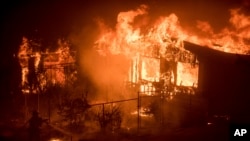Wildfires barreled across the baking landscape of the western U.S. and Canada, destroying a smattering of homes, forcing thousands to flee and temporarily trapping children and counselors at a California campground.
Here's a look at the wildfires blackening the West.
British Columbia
Firefighters were contending with more than 200 wildfires burning in British Columbia that had destroyed dozens of buildings, including several homes and two airport hangars. The three biggest fires, which ranged in size from 5 to 8 square miles (14 to 20 square kilometers), had forced thousands of people to flee.
"We are just, in many ways, at the beginning of the worst part of the fire season and we watch the weather, we watch the wind, and we pray for rain," outgoing Premier Christy Clark told reporters in Kamloops.
Rob Schweizer, manager of the Kamloops Fire Centre, said it had been an unprecedented 24 hours.
"We probably haven't seen this sort of activity that involves so many residences and people in the history of the province of B.C.," he said.
Northern California
In Northern California, a Butte County wildfire swept through grassy foothills and destroyed 10 structures, including homes, and led to several minor injuries.
Burned-out pickup trucks were left in ashes, surrounded by charred, leafless trees. The metal frame of a mobile home and a vintage stove were left standing in scorched debris at one site.
The blaze about 60 miles north of Sacramento grew rapidly to more than 7 square miles (18 square kilometers) and was nearly 20 percent contained, according to the California Department of Forestry and Fire Protection. At least 750 homes remained threatened and hundreds more were evacuated.
"We're hopeful about holding the lines," fire spokeswoman Mary Ann Aldrich said Sunday. "There's been progress."
The area burning was about 10 miles (16 kilometers) south of Oroville, where spillways in the nation's tallest dam began crumbling from heavy rains this winter and led to temporary evacuation orders for 200,000 residents downstream. On Saturday, authorities issued an evacuation for about 250 homes threatened by the fire.
Southern California
Southern California crews hope slightly cooler temperatures and diminishing winds will help in the battle Sunday against major wildfires that have destroyed structures, closed a highway and forced evacuations.
One of two fires raging in Santa Barbara County grew to 12 square miles (31 square kilometers), traversing a mountain range and heading south toward coastal Goleta.
"The plan is to hit it with air tankers to keep it from moving to the south and to the east," said county fire Capt. Dave Zaniboni. "There's less heat and less wind, which makes things a little easier."
There was minimal containment and flames shut down State Route 154. About 90 children and 50 counselors were stuck Saturday at the Circle V Ranch and had to take shelter until they could be safely evacuated. Buildings have burned but officials weren't yet sure if they were homes.
Crews were also using an air attack against another blaze about 50 miles north that exploded in size to 37.5 square miles (97 square kilometers). About 200 rural homes east of Santa Maria were evacuated after the fire broke out Saturday and was fed by dry gusts.
Elsewhere in the west
Firefighters have been able to build containment lines around about half the wildfire that forced the evacuation of hundreds of people near Breckenridge, Colorado. The fire has not spread since it broke out Wednesday and was still less than a square mile (about one-third square kilometer) Sunday.
In rural Arizona, fire officials say three homes were among 10 buildings that were burned. The wildfire there has led to the evacuation of the entire town of Dudleyville, about 100 miles (160 kilometers) southeast of Phoenix.
A wildfire burning in near Summer Lake in south-central Oregon has destroyed a hunting cabin and an outbuilding.
And in Nevada, fire officials have ordered evacuations for a wildfire that is near the same area where another blaze has already burned for days.






